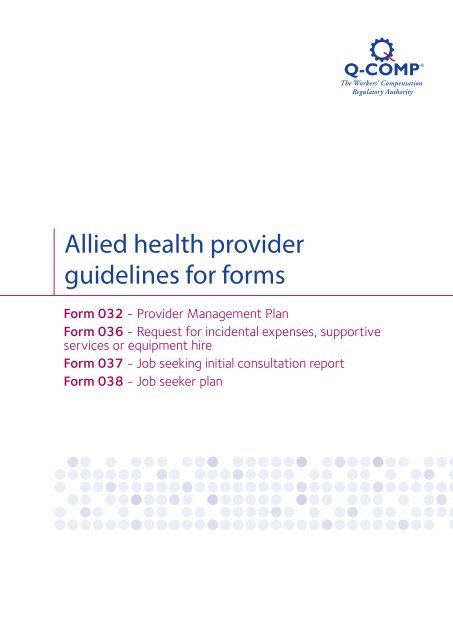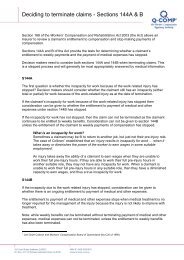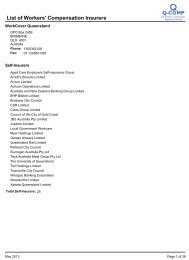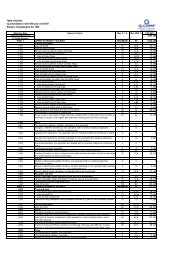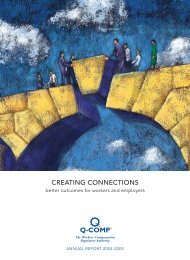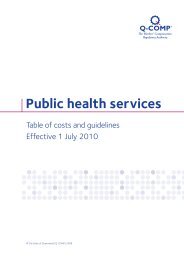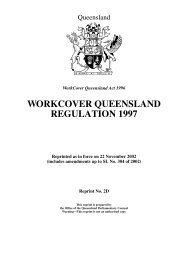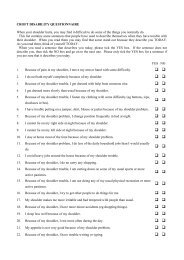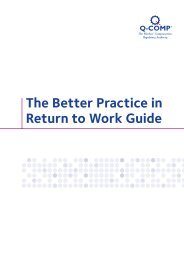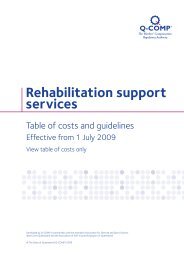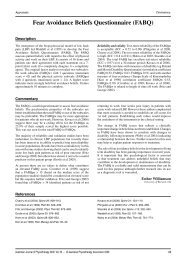Allied health provider guidelines for forms - Q-Comp
Allied health provider guidelines for forms - Q-Comp
Allied health provider guidelines for forms - Q-Comp
You also want an ePaper? Increase the reach of your titles
YUMPU automatically turns print PDFs into web optimized ePapers that Google loves.
<strong>Allied</strong> <strong>health</strong> <strong>provider</strong><br />
<strong>guidelines</strong> <strong>for</strong> <strong>for</strong>ms<br />
Form 032 - Provider Management Plan<br />
Form 036 - Request <strong>for</strong> incidental expenses, supportive<br />
services or equipment hire<br />
Form 037 - Job seeking initial consultation report<br />
Form 038 - Job seeker plan
Form 032 - Provider Management Plan<br />
Introduction<br />
The Provider Management Plan (PMP) is designed to provide basic in<strong>for</strong>mation at a level that keeps the insurer<br />
and worker in<strong>for</strong>med on the planned intervention. If the referrer is requesting greater detail or the issues are<br />
so significant that the PMP cannot accommodate the required in<strong>for</strong>mation, then the PMP may not be the<br />
appropriate <strong>for</strong>m. A report where outcomes and barriers can be better detailed may be more appropriate.<br />
The PMP is applicable to:<br />
• Chiropractors<br />
• Exercise physiologists<br />
• Occupational therapists<br />
• Oesteopaths<br />
• Physiotherapists<br />
• Podiatrists<br />
• Psychologists<br />
• Speech pathologists<br />
• other <strong>provider</strong>s where prior approval is requested<br />
The PMP is to be completed:<br />
• towards the completion of the pre-approved sessions if further treatment is required<br />
• towards the completion of approved sessions if further treatment is required<br />
• by any <strong>provider</strong> after initial consultation where prior approval is required be<strong>for</strong>e treatment is provided.<br />
Please <strong>for</strong>ward the PMP to the insurer promptly so that their approval or otherwise of future sessions does<br />
not interrupt continued treatment. Submitting other PMP should be done in the Insurer’s preferred method eg:<br />
phone, fax or email.<br />
Provide copies of the PMP to the:<br />
• insurer<br />
• worker—if the worker is to sign the PMP<br />
• referring medical practitioner, if appropriate.<br />
Make sure you keep a copy <strong>for</strong> your records.<br />
Guidelines <strong>for</strong> completing the Provider Management Plan<br />
The following <strong>guidelines</strong> will assist you in completing the relevant fields in the Provider Management Plan.<br />
Examples are provided <strong>for</strong> a physical injury as well as a psychological injury.<br />
<strong>Comp</strong>lete worker’s details and Provider Management Plan details.<br />
Guidelines <strong>for</strong> allied <strong>health</strong> <strong>provider</strong> <strong>for</strong>ms<br />
2
Treatment plan and predicted return to work status.<br />
List details of treatment procedures currently being provided (including specifi c modalities) and those that you<br />
anticipate will be required in the near future. Use abbreviations like STM (soft tissue mobilisation); HEP (home<br />
exercise program); U/S (ultrasound); MOBS (mobilisation); Tx (traction); C/S (cervical spine); T/S (thoracic spine)<br />
and L/S (lumbar spine) where possible.<br />
You should design the treatment to achieve the expected outcomes and to be consistent with the expected<br />
management of the injury sustained.<br />
Treatment plan<br />
Gym strengthening program. Recommend work<br />
bench modification to suit worker. Commence<br />
suitable duties.<br />
Treatment plan<br />
Educate on PTSD, teach relaxation techniques,<br />
behaviours to address fear & depression,<br />
graduate exposure to workplace.<br />
Sample treatment plans <strong>for</strong> a physical injury and a psychological injury.<br />
Type and number of consultations being provided<br />
Refer to the appropriate table of costs <strong>for</strong> the item number services.<br />
Outcome measures used to assess and monitor worker’s progress throughout treatment period<br />
Outcome measures<br />
The outcome measure must be relevant to the compensated injury as these can guide clinical reasoning and assist<br />
in evaluating the worker’s progress. The outcome measures identifi ed will assist the insurer to determine the<br />
reasonable necessity of proposed management.<br />
Outcome measures should be:<br />
• reliable, valid and sensitive to change<br />
• described in specific terms<br />
• quantifiable or measurable<br />
• time-referenced wherever possible<br />
• relevant to the worker’s injury<br />
• relevant to the outcome of intervention.<br />
• The outcome measures are reported as:<br />
• Measures (at initial assessment) – where were they—provide objective measures relating to outcome<br />
measure at the time of initial consultation<br />
• Current measures (at commencement of this plan) – where are they now—the current objective measures<br />
Guidelines <strong>for</strong> allied <strong>health</strong> <strong>provider</strong> <strong>for</strong>ms<br />
3
elating to outcome measure at the date of developing this plan<br />
• Anticipated outcomes (at end of current plan) – where will they be—detail what you anticipate will be<br />
achieved at the conclusion of this plan.<br />
Outcome measures used to assess and monitor worker’s progress throughout treatment period<br />
Outcome measures<br />
Pain inventory 9/10 at rest 5/10 with activity 1/10 with activity<br />
Standing tolerance 2 minutes 1 hour 3hours<br />
DASS Moderate Moderate Mild<br />
Sample outcome measures <strong>for</strong> physical and psychological injuries<br />
Identified barriers to return to work and recommended strategies to overcome barriers<br />
Barriers<br />
Outline any identified barrier/s to return to work that may impact on your proposed treatment— <strong>for</strong> example,<br />
the worker’s fear of re-injury, lack of available suitable duties at the workplace or an ergonomic issue.<br />
Recommended strategies<br />
Measures<br />
(at initial assessment)<br />
Current measures<br />
(at beginning of plan)<br />
If you are able, indicate what strategies might overcome the barriers. These may not necessarily refer to your<br />
particular discipline—it may be a suggestion to refer to another discipline <strong>for</strong> assessment/ treatment.<br />
Physical injury example: you are treating a factory line worker <strong>for</strong> a back injury but you are aware that the<br />
work heights at their workplace are too low and may be the source of ongoing aggravation to their back. If left<br />
unaddressed this may impact on the effectiveness of your treatment of their back condition, there<strong>for</strong>e it may be<br />
appropriate to recommend a worksite assessment to ensure work heights are appropriate.<br />
Identified barriers to return to work and recommended strategies to overcome barriers<br />
Barriers<br />
Bench height too low<br />
Recommended strategies<br />
Anticipated outcomes<br />
(at end of current plan)<br />
Modify work bench to suit worker<br />
Psychological injury example: you are treating a worker <strong>for</strong> workplace bullying and become aware that<br />
the supervisor has not addressed the situation with the bully. The worker will be returning to the same<br />
work situation, which left unaddressed will impact on the effectiveness of your treatment. It may be<br />
appropriate to recommend a workplace meeting with the supervisor to coach/recommend processes to<br />
address the situation be<strong>for</strong>e your client returns.<br />
Identified barriers to return to work and recommended strategies to overcome barriers<br />
Barriers<br />
Avoidant behaviours<br />
Recommended strategies<br />
Hierarchical de-sensitisation<br />
Guidelines <strong>for</strong> allied <strong>health</strong> <strong>provider</strong> <strong>for</strong>ms<br />
4
Worker’s consent<br />
Ensure that the worker understands their injury, the type of treatment to be undertaken, timeframes and most<br />
importantly, the expectations of the treatment. In<strong>for</strong>mation assists the worker to understand their injury and<br />
its management, make choices, overcome unhelpful beliefs and modify behaviour. It is recommended that the<br />
worker sign the <strong>for</strong>m once they understand what is expected of them, however it is not compulsury.<br />
Guidelines <strong>for</strong> allied <strong>health</strong> <strong>provider</strong> <strong>for</strong>ms<br />
5
Form 036 - Request <strong>for</strong> incidental expenses,<br />
supportive devices or equipment hire<br />
Introduction<br />
Use <strong>for</strong>m 36 to request approval from the insurer <strong>for</strong>:<br />
• incidental expenses exceeding $50.00 per claim<br />
• supportive devices exceeding $100.00 per claim<br />
• the hire of equipment to workers<br />
What is considered a supportive device<br />
Reasonable supportive devices are those that can be shown to be necessary <strong>for</strong> successful treatment of the<br />
compensable injure (e.g. splinting material, prefabricated splints and braces).<br />
What is considered hire equipment<br />
Equipment items considered clinically necessary to assist the worker to recover but are not necessary <strong>for</strong> long<br />
term recovery. This can also be used where the loan of the equipment is more cost effective than purchasing the<br />
equipment <strong>for</strong> the worker (e.g. crutches or wheelchair hire).<br />
Incidental expense / supportive device details<br />
Detail incidental expenses and/or supportive devices which exceed the pre-approved amount payable <strong>for</strong> each<br />
claim. Check with the individual insurer <strong>for</strong> the types of incidental/supportive devices they will approve. (Note:<br />
this <strong>for</strong>m is not required <strong>for</strong> any of the podiatry items listed in the Podiatry services table of costs).<br />
Equipment hire details<br />
Detail the equipment to be hired by the injured worker.<br />
Guidelines <strong>for</strong> allied <strong>health</strong> <strong>provider</strong> <strong>for</strong>ms<br />
6
Form 037 - Job seeking initial consultaiton<br />
report<br />
Introduction<br />
Use this <strong>for</strong>m when you are assisting a worker to identify transferable skills <strong>for</strong> a new job/career or host<br />
placement. It involves the development of a vocational preparation action plan with the worker.<br />
Aim<br />
The aim of the job seeking initial consultation report is to:<br />
• identify transferable skills<br />
• identify current job market opportunities<br />
• set realistic work goals.<br />
Guidelines <strong>for</strong> completing the job seeking initial consultation report<br />
General In<strong>for</strong>mation<br />
An initial job seeking consultation is indicated when the worker:<br />
• cannot return to their pre-injury work and there are no suitable duties or alternative career/job options with<br />
their current employer<br />
• needs assistance to identify sustainable alternative work options suited to their functional abilities and skills<br />
• needs to undertake a host employment placement and requires initial guidance and preparation.<br />
Reason <strong>for</strong> referral to job seeking initial consultation<br />
Document the reason <strong>for</strong> the insurer’s request here. If you are unclear as to why the insurer requires the<br />
consultation, clarify this prior to contact with the worker.<br />
Sources of medical in<strong>for</strong>mation relied upon <strong>for</strong> this report (e.g. medical reports)<br />
Document contact you have had with the treating medical practitioner or allied <strong>health</strong> <strong>provider</strong> or any reports<br />
you have had access to in <strong>for</strong>mulating your opinion.<br />
Worker’s injury condition<br />
Document any medical restrictions <strong>for</strong> the worker. This in<strong>for</strong>mation may come from medical reports or<br />
from communication with the medical practitioner or allied <strong>health</strong> <strong>provider</strong>. In<strong>for</strong>mation may include medical<br />
restrictions, impact of injury, functional abilities and tolerances.<br />
Guidelines <strong>for</strong> allied <strong>health</strong> <strong>provider</strong> <strong>for</strong>ms<br />
7
Worker’s perspective of factors impacting on return to work<br />
Note any concerns or expectations the worker has about returning to work. This may include:<br />
• how the injury has impacted on the worker—such as their understanding of their current injury/ condition and<br />
their perception of their capacity to return to work<br />
• motivation to return to work<br />
• issues related to home and family situation and other pressures<br />
• social impact of the injury<br />
• worker’s lifestyle post-injury<br />
• their attitude to their previous employer (at the time of injury) and/or finding a new job.<br />
Worker’s literacy<br />
Where relevant, comment on reading and writing abilities. Make reference to the worker’s first language. If their<br />
first language is not English, comment on their participation in any English or literacy courses.<br />
Worker’s current education/qualifications<br />
Document the worker’s qualifications from <strong>for</strong>mal schooling, any courses attended and any licences obtained<br />
such as <strong>for</strong>klift and truck.<br />
Worker’s employment history<br />
Starting with the most recent job, document the job title, employer/company’s name, type of duties (physical<br />
and psychological demands of the job as advised by the worker) and employment period (where possible, dates<br />
of employment and minimum length of employment with each employer).<br />
Worker’s job interests<br />
List the worker’s interests, skills and hobbies. This will assist to clarify other skills and interests the worker may<br />
have developed outside of the work situation that can be used in expanding job options.<br />
Identification of suitable employment options<br />
Recommend suitable employment options after considering the worker’s job interests, transferable skills and<br />
education level. Base vocational options on objective marketplace analysis—include job opportunities in the<br />
worker’s residential area and evidence provided via two local options such as the worker’s local newspaper and<br />
job website. Ensure that the identified work options are realistic and achievable considering the worker’s skills,<br />
location and access to chosen occupational pathways.<br />
Guidelines <strong>for</strong> allied <strong>health</strong> <strong>provider</strong> <strong>for</strong>ms<br />
8
Worker’s access to transport<br />
Consider issues such as the worker’s access to transport, travelling time, mode and distance as it assists to<br />
identify suitable employment options.<br />
Occupational details<br />
Following consideration of all available in<strong>for</strong>mation, nominate the jobs the workers is most suited to under<br />
occupational details in order of priority. List why these occupations are achievable and why they match the<br />
worker’s transferable skills/abilities.<br />
Labour market analysis<br />
The availability of the jobs listed must be tested through a labour market analysis relevant to the worker<br />
and where the worker resides. You must provide a detailed analysis of the labour market demonstrating the<br />
availability of suitable jobs in the local area from at least two sources—<strong>for</strong> example the web, newspapers.<br />
Guidelines <strong>for</strong> allied <strong>health</strong> <strong>provider</strong> <strong>for</strong>ms<br />
9
Form 038 - Job seeker plan<br />
Introduction<br />
Use <strong>for</strong>m 38 in consultation with the worker when you are assisting a worker to seek employment<br />
Aim<br />
The aim of the job seeker plan is to:<br />
• document a plan of action <strong>for</strong> seeking employment<br />
• have the worker take responsibility <strong>for</strong> the plan<br />
<strong>Comp</strong>leting the job seeker plan<br />
A job seeker plan is used to:<br />
• outline suitable employment option goals <strong>for</strong> the worker (these options may have been previously identified in<br />
the job seeking initial consultation report).<br />
• outline the actions agreed between the <strong>provider</strong> and the worker to achieve a return to work<br />
Details<br />
Insert worker and <strong>provider</strong>’s contact details.<br />
The date the job seeker plan commenced and the expected completion date.<br />
Suitable employment option goals<br />
List the suitable employment option goals that are realistic and have been agreed to by both the worker and the<br />
<strong>provider</strong>.<br />
The job seeker plan<br />
List all of the actions required to return to the suitable employment option goals.<br />
Detail who is to complete the actions listed (either the worker or the <strong>provider</strong>)<br />
Insert the completion date <strong>for</strong> each action as they are completed<br />
Worker’s agreement<br />
Ensure that the worker understands the plan and the actions that are required to achieve the employment option<br />
goals. It is recommended that the worker sign the <strong>for</strong>m to indicate their understanding and agreement of the<br />
plan and the actions they are expected to carry out.<br />
Guidelines <strong>for</strong> allied <strong>health</strong> <strong>provider</strong> <strong>for</strong>ms<br />
10


